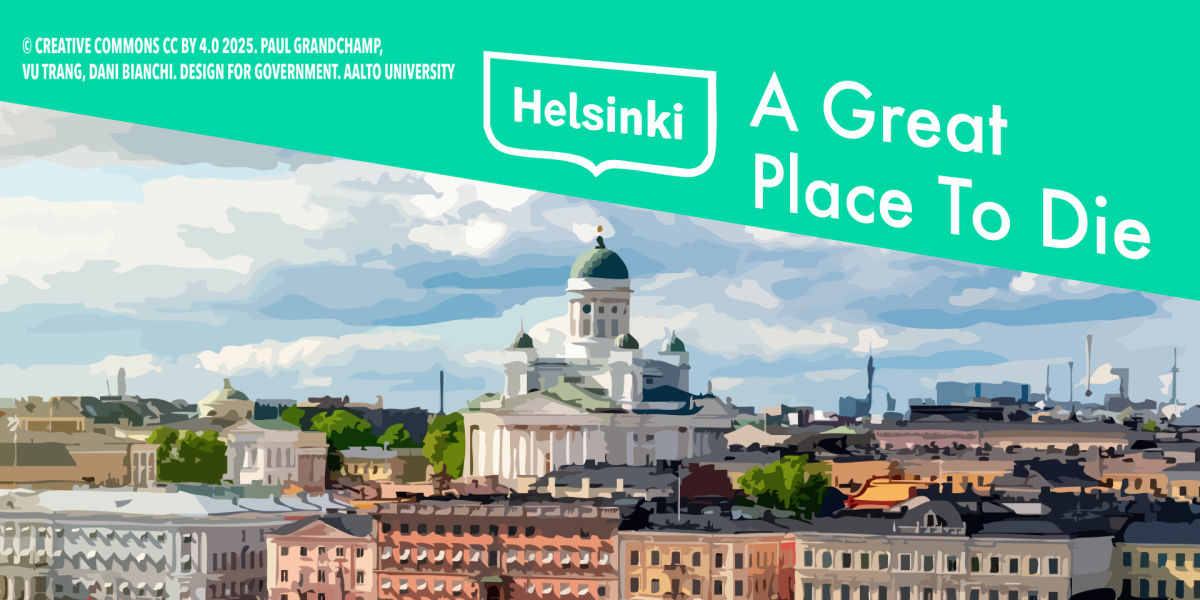This blog post reports on work-in-progress within the DfG course! The post is written by the
‘Open Governance’ workstream dealing with the Ministry of Finance’s brief on ‘Open
Government for an Age-Friendly Finland.’ The group includes Dani Bianchi from the
Collaborative and Industrial Design program (Aalto), Paul Grandchamp from the Creative
Sustainability program (Aalto, Design Track), and Vu Trang from the Sustainable
Entrepreneurship program (Aalto).
Written by: Paul Grandchamp
Introduction:
This spring, our Design for Government class is exploring how Finland’s commitment to open
governance engages and supports older citizens as active participants in society. To tackle this,
we are collaborating with the Ministry of Finance, working to ensure that government policies
and initiatives effectively address the needs, opportunities, and challenges of an aging
population. Given the complexity of this topic, our open government group has started by
dividing into four workstreams, each addressing a different aspect of the challenge.
My workstream is focused on how Finland promotes best practices in open government, both
domestically and internationally. This has involved briefing ourselves on Finland’s commitments
within the Open Government Partnership (OGP), analyzing policy documents, and engaging
with experts to understand how these initiatives become part of practice. So far, I have a couple
of insights that I’d like to share with you:
Alignment of Vocabulary:
Before diving into this project, our group stepped back to ask: What are we really responding to
when addressing aging? If age is more than just a number, how do we articulate the lived
experiences of older adults without reinforcing outdated assumptions? And what underexplored
gaps exist in how open governance engages with underrepresented groups?
From the start, it was clear that language use plays an influential role. A term as seemingly
neutral as “the elderly” subtly creates an ‘us versus them’ mindset. This can position older
adults as a separate, dependent, and even burdensome group rather than as individuals with
diverse experiences, care needs, and aspirations. During our Aging Panel, a discussion held in
our class, one panelist put it bluntly: “We need to move beyond ‘fragile’ definitions of older
adults”. Instead of seeing aging as a problem, what if we framed it as an opportunity—one
where Finland could lead the way or, as my Professor Marco Steinberg suggested, become “a
great place to die”?
A perfect metaphor for this emerged during the panel: Think of Premier League footballers
nearing the end of their careers. Do they just retire and fade into the background? Not always.
Many transition to Major League Soccer, continuing to play in a less competitive but active
environment. Similarly, governance should engage older adults as active contributors, not
passive recipients. If we continue to frame aging through a lens of fragility, our policies will
reflect that—prioritizing reaction over prevention (and anticipation), and placation over
participation. But by shifting the narrative, we open doors to more inclusive approaches in open
governance.

Figure 1: Some of the Finnish digital platforms for civic engagement.
What Does Meaningful Public Participation Look Like?
With the advent of digital technology, citizens—with the appropriate digital literacy and access to
them—now have unprecedented tools to engage with and hold governments accountable. In
Finland, platforms for public comments and municipal initiatives provide some examples of
avenues for contributing to government policy, implementation, and vision. However, while
these tools create opportunities for civic engagement, it’s sometimes difficult to tell whether they
meaningfully influence anything or not. Thus, meaningful participation is more than just being
heard—it requires a sense of belonging, a clear understanding of how to engage effectively,
evidence of the impact of one’s contributions, and transparency about what happens after
participation. Without these elements, participation risks becoming symbolic rather than
substantive, potentially eroding trust in government processes.
For instance, the Open Government Finland’s very own National Dialogues are structured
discussions designed to gather citizen input on key policy issues such as security, trust, and
mental health. However, as the Open Government Partnership’s Independent Reporting
Mechanism (2023) notes, there is currently no systematic process to ensure that insights from
Finland’s National Dialogues are channeled into policy change. This challenge is not unique to
Finland but is common across participatory governance models worldwide. As Open
Government Finland advances its fifth action plan, a crucial next step is ensuring that civic
engagement—particularly from underrepresented groups like senior citizens—leads to concrete,
measurable outcomes. As someone interested in participatory design, this is an exciting
challenge to look into further.
Is An Incremental Approach Enough?
“Continuity has been an important aspect of the Nordic model — system maintaining rather than
system changing.” — Jan-Erik Johansson, Guest Lecturer, DfG (03/04/2025).
Since joining the OGP in 2013, Finland has focused on pursuing a series of small but steady
reforms, from expanding access to open data to providing public service training (Independent
Reporting Mechanism, 2023). Incrementalism, understood as a policy process model in which
gradual changes accumulate over time to create a bigger impact rather than relying on dramatic
shifts, has its strengths. It allows for careful testing of new policies, reduces the risk of
unintended consequences, and ensures that reforms are politically feasible. However, at what
point does this approach become a barrier to more ambitious change?
Take, for example, Finland’s recent social and healthcare reforms, which centralized municipal
services into Wellbeing Service Counties (WSCs). While this restructuring aimed to improve
service provision, the implications are still unclear. As Pekkola et al (2023) point out, “from the
perspective of democracy, there are now three different layers of representative democracy: the
national parliament (selected from voting districts), the municipal democracy, and the regional
democracy in Wellbeing Service Counties (WSCs). […] It remains to be seen what it means to
be a ‘citizen’ of a WSC and how this citizenship will be related to an identity and the role of
democracy for the citizenship within a municipality and nationally.”
For older adults (well, anyone really), understanding these new administrative structures could
be challenging. As decision-making moves higher up the administrative ladder, does it risk
leaving behind those already struggling to engage? I’m curious to learn more about Open
Government Finland’s incremental approach and its success in addressing this shift during our
upcoming roundtable discussion.
Next steps:
The mid-cycle review of Finland’s Open Government 2023-2027 action plan is taking place this
year, providing us with an exciting opportunity to contribute. As we continue working towards a
shared vision of a truly open government for which clear-cut solutions and directions do not
exist, we remind ourselves to be curious, collaborative, and committed. For our upcoming
roundtable discussion—a participatory instance that is a part of the course—with folks from the
Ministry of Finance and the Elderly Citizens Council, we’re eager to clarify the many questions
that have emerged in our research. But beyond just seeking out ‘answers,’ we’re also paying
attention to moments of frustration, joy, doubt, and even gossip—because working in this space
involves embracing uncertainty.
We look forward to keeping you in the loop as we piece together parts of this puzzle. If you have
any thoughts or questions, we’d love to hear what you think!
References:
Kansalliset Dialogit. (n.d.). National dialogues. Retrieved March 4, 2025, from
https://kansallisetdialogit.fi/en/
Kuntalaisaloite.fi. (n.d.). Kuntalaisaloite. Retrieved March 4, 2025, from
https://www.kuntalaisaloite.fi/fi
Independent Reporting Mechanism. Action Plan Review: Finland 2023–2027. IRM, 2023.
Retrieved from https://www.opengovpartnership.org/wpcontent/uploads/2024/03/Finland_Action-Plan-Review_2023-2027_EN.pdf
Open Government Partnership. “Three Pathways to More Meaningful Public Participation.”
Open Government Partnership, 5 March 2025,
https://www.opengovpartnership.org/stories/three-pathways-to-more-meaningful-publicparticipation/.
Otakantaa.fi. Retrieved March 4, 2025, from https://www.otakantaa.fi/fi/
Pekkola, Elias, et al. “The structures of the Finnish public administration.” Finnish public
administration: Nordic public space and agency. Cham: Springer International Publishing, 2023.
57-75.
The DfG course runs for 14 weeks each spring – the 2025 course has now started and runs from 24th Feb to 27th May. It’s an advanced studio course in which students work in multidisciplinary teams to address project briefs commissioned by governmental ministries in Finland. The course proceeds through the spring as a series of teaching modules in which various research and design methods are applied to address the project briefs. Blog posts are written by student groups, in which they share news, experiences and insights from within the course activities and their project development. More information here about the DfG 2025 project briefs. Hold the date for the public finale on Tuesday 27th May!

